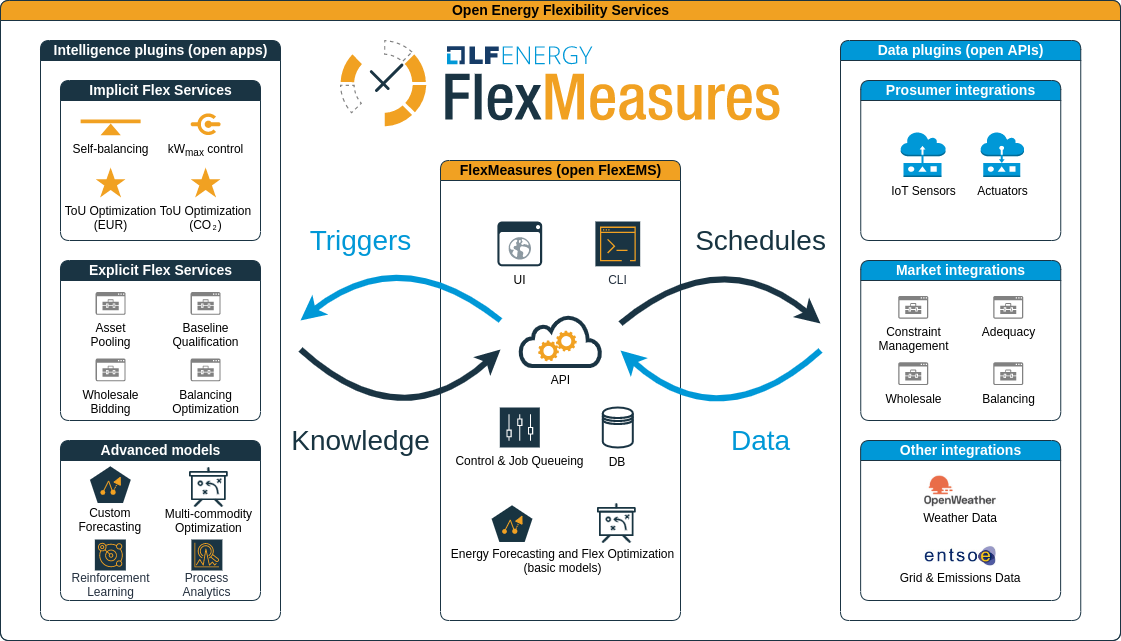Welcome to the FlexMeasures documentation!
FlexMeasures is the intelligent & developer-friendly EMS to support real-time energy flexibility apps, rapidly and scalable.
In a world with renewable energy, flexibility is crucial and valuable, e.g. for demand response. Planning ahead allows flexible assets to serve the whole system with their flexibility, e.g. by shifting or curtailing energy use.
Developing energy flexibility services is expensive work. FlexMeasures is designed to be developer-friendly, which helps you to go to market quickly, while keeping the costs of software development at bay. FlexMeasures supports:
Real-time data intelligence & integration
Uncertainty models
App-building (API/UI/CLI & plugin support)
FlexMeasures proudly is an incubation project at the Linux Energy Foundation.
A quick glance at usage
A tiny, but complete example: Let’s install FlexMeasures from scratch. Then, using only the terminal, load hourly prices and optimize a 12h-schedule for a battery that is half full at the beginning.
$ pip install flexmeasures # also available via Docker
$ docker pull postgres; docker run --name pg-docker -e POSTGRES_PASSWORD=docker -e POSTGRES_DB=flexmeasures-db -d -p 5433:5432 postgres:latest
$ export SQLALCHEMY_DATABASE_URI="postgresql://postgres:docker@127.0.0.1:5433/flexmeasures-db" && export SECRET_KEY=notsecret
$ flexmeasures db upgrade # create tables
$ flexmeasures add toy-account --kind battery # setup account & a user, a battery (Id 2) and a market (Id 3)
$ flexmeasures add beliefs --sensor-id 3 --source toy-user prices-tomorrow.csv # load prices, also possible per API
$ flexmeasures add schedule --sensor-id 2 --optimization-context-id 3 \
--start ${TOMORROW}T07:00+01:00 --duration PT12H \
--soc-at-start 50% --roundtrip-efficiency 90% # this is also possible per API
$ flexmeasures show beliefs --sensor-id 2 --start ${TOMORROW}T07:00:00+01:00 --duration PT12H # also visible per UI, of course
We discuss this in more depth at Toy example: Scheduling a battery, from scratch.
Use cases
As possible users, we see energy service companies (ESCOs) who want to build real-time apps & services around energy flexibility for their customers, or medium/large industrials who are looking for support in their internal digital tooling.
However, even small companies and hobby projects might find FlexMeasures useful! We are constantly improving the ease of use.
FlexMeasures can be used as your EMS, but it can also integrate with existing systems as a smart backend, or as an add-on to deal with energy flexibility specifically.
The image below shows how FlexMeasures, with the help of plugins fitted for a given use case, turns data into optimized schedules:

You (the reader) might be a user connecting with a FlexMeasures server or working on hosting FlexMeasures. Maybe you are planning to develop a plugin or even core functionality. In Getting started, we have some helpful tips how to dive into this documentation!
Three ways in which FlexMeasures supports developers
Real-time data intelligence & integration
Energy flexibility services need to interact multiple times per day or hour. We equipped FlexMeasures with:
Support for real-time updates
Forecasting for the upcoming hours
Schedule optimization
Extensions for integrating data, e.g. from ENTSO-E or OpenWeatherMap
Uncertainty models
Dealing with uncertain forecasts and outcomes is crucial.
FlexMeasures is therefore built on the timely-beliefs framework, so we model this real-world aspect accurately.
App building
Building customer-facing apps & services is where developers make impact. We make their work easy.
Well-documented API and CLI
Plugin support (add your own logic)
Backend UI and support for plotting
Multi-tenancy
For more on FlexMeasures services, read In-built smart functionality. Or head right over to Getting started.
Using FlexMeasures benefits operators as well as asset owners, by allowing for automation, insight, autonomy and profit sharing. For more on benefits, consult Benefits.
FlexMeasures is compliant with the Universal Smart Energy Framework (USEF). Therefore, this documentation uses USEF terminology, e.g. for role definitions. In this context, the intended users of FlexMeasures are a Supplier (energy company) and its Prosumers (asset owners who have energy contracts with that Supplier). The platform operator of FlexMeasures can be an Aggregator.
Concepts
Tutorials
The in-built UI
The API
Hosting FlexMeasures
Developing Plugins